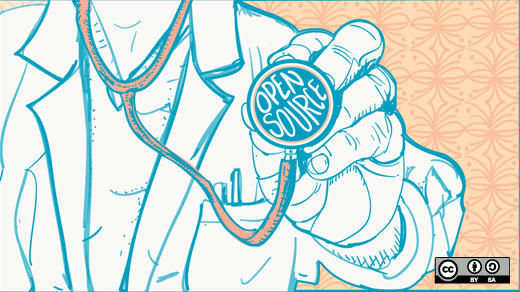In the summer of 2022, the UK government and NHS England published its Open Source Policy, stating that open source technology is:
Particularly suitable for use within the healthcare industry where, through active collaboration between IT suppliers and user/clinicians communities, solutions can be honed to maximise benefits to delivery of health and social care.
The public statement by NHS England is just the latest development in a broader trend: The wholehearted embrace of open source software by the healthcare sector. And no wonder; open source presents myriad opportunities for this most complex of industries, with potential solutions across various sub-sectors. Yes, open source is now powering everything from medical wearables to healthcare human resource management.
Health informatics
Information technology is playing an increasingly vital role in every sector of the economy, with the healthcare industry no exception. One of the most important developments in this field is the growth of health informatics—in other words, the acquisition and analysis of all types of patient data, including test results, scans, and electronic health records (EHR).
Informatics is all about providing better health outcomes for patients, but essential to this are standardization and interoperability—and this is where open source can make a big difference because of its truly collaborative and "open" nature.
Open source developers have created numerous software solutions for various businesses and organizations within the healthcare sector. First, it is probably worth distinguishing between healthcare software and medical software.
Open source medical software
Medical software refers specifically to medical devices and direct patient care/treatment. It also includes tools for monitoring, analyzing and interpreting data, and a range of other functions. Medical software can be designed for treatment, simulation, or medical training.
Some of the best applications of this are in smartphone apps, allowing patients to track vitals from home. Glucosio is an Android and iOS app enabling people with diabetes to monitor glucose levels while simultaneously supporting diabetes research.
[ Also read Automation: 5 ways it can change lives ]
Imaging and visualization are other fields where open source software provides solutions. One of these is Slicer, a free, open source package written in C++, Python, and Qt. Slicer includes image analysis and scientific visualization tools. Medical professionals use it for various medical applications as diverse as autism, multiple sclerosis, systemic lupus erythematosus, prostate cancer, lung cancer, breast cancer, schizophrenia, orthopedic biomechanics, COPD, cardiovascular disease, and neurosurgery. Studierfenster is another free, open source product. It is an online server-based framework for medical image processing that displays 2D and 3D images in a standard web browser.
Open source healthcare software
Healthcare software is a broader term covering any software developed for the healthcare industry. It encompasses medical solutions, including tools for diagnosis or treatment optimization, but also covers tools that aid with infrastructure services, patient information, public health, and other auxiliary requirements. It is possible here that open source software has the biggest impact on the sector.
Perhaps the most ubiquitous examples of open source software in the healthcare sector are those designed to manage patient records, with applications such as Open Hospital, Open EMR, and Open MRS all helping hospitals and surgeries to hold and manage electronic health records (EHR). Open Dental offers a similar service for dentistry providers and can also be utilized for practice management, including billing and electronic charting.
Hospital Run is another patient record application specifically designed to improve the accessibility of healthcare in developing countries, with an "offline-first" approach to managing healthcare records.
Governments also use open source software for applications in health system management, public health, and biosurveillance. The integrated Human Resource Information System (iHRIS) developed by IntraHealth International helps countries track data about their healthcare workforce and is already being used in over 20 countries worldwide.
Epi Info is statistical software for epidemiology, an open source, public domain tool developed by the USA's Centers for Disease Control and Prevention (CDC). Another tool used to model and visualize the spread of infectious diseases is the Spatiotemporal Epidemiological Modeler, originally developed at IBM Research but freely available through the Eclipse Foundation.
Unique solutions are also being developed for disease management, including collections of applications like Breathing Games—a series of research-backed games under Peer Production licenses created for the prevention, diagnosis, and treatment of chronic respiratory diseases—and Nightscout—a suite of software tools which allow continuous glucose monitoring from the home using cloud technology.
Benefits of open source in healthcare
Open source software has the potential to bring together a host of relevant healthcare stakeholders, including government agencies, medical equipment vendors, healthcare service providers, and research agencies, by facilitating standardization and interoperability in health informatics. But the benefits of open source go beyond this.
Because of the transparency of open source development, there is a large degree of flexibility, with many highly customizable solutions. Furthermore, the open source community has a clearly defined vision with strong motivation from users and developers alike to improve and maintain applications. There is also the potential for open source software to provide increased security due to the reduced reliance on third-party suppliers and the adoption of blockchain technologies—most of which remain open source.
And finally, for a sector struggling with many global crises, the improved cost-benefit ratio of open source software is not an insignificant consideration.
Open source—the answer for a sector under unprecedented pressure?
The healthcare sector is being forced to adapt rapidly due to multiple pressures, and as a result, technological solutions are becoming increasingly important. As open source software becomes more reliable, healthcare organizations realize tangible benefits from its transparency, security, and flexibility. It's clear that open source presents an array of benefits for the industry, aiding not just developed but also developing economies.







3 Comments